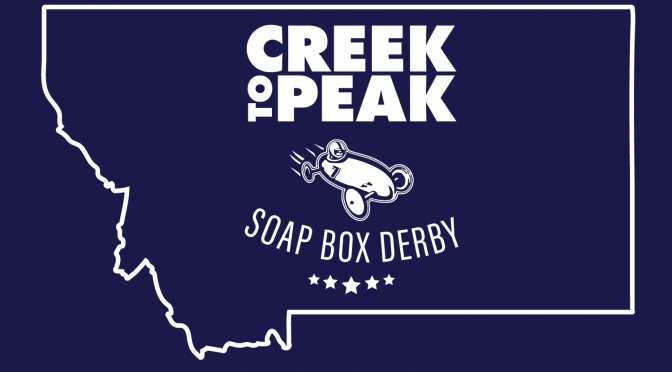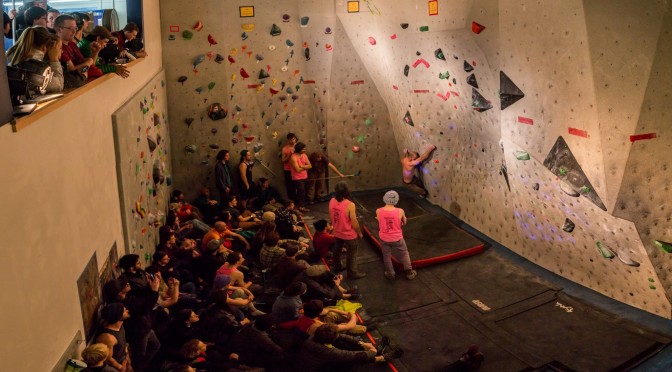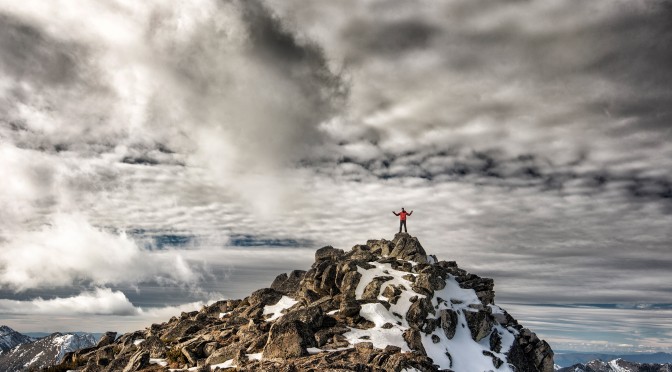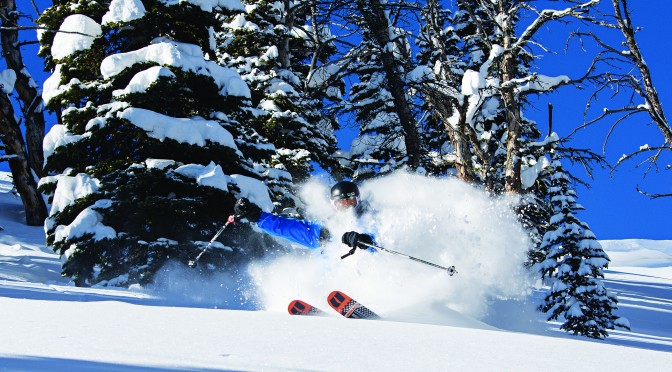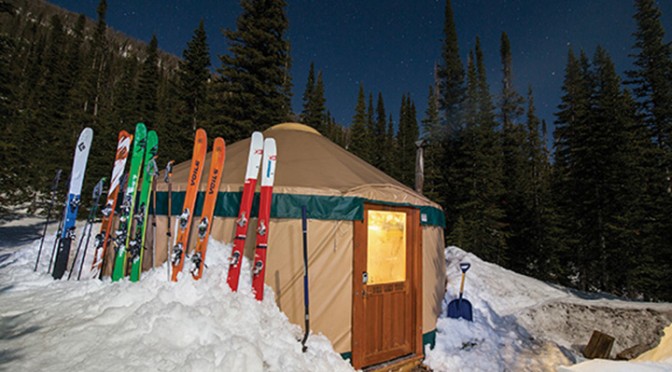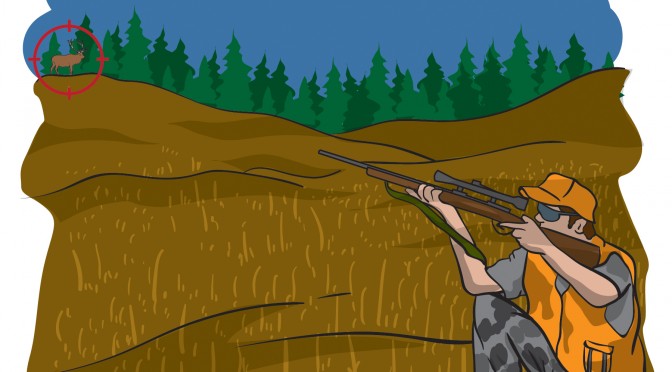Don’t forget to snap a pic on your next outdoor adventure. Entries can be sent to [email protected], for a chance to win some sweet outdoor loot.
All posts by pocket@dmin
Man-Made Mountain Machines
by Taylor Burlage
A new brand of mountain racing in southwest Montana
Engineering students with an adrenaline addiction, your time has come. The 2nd Annual Creek to Peak Soap Box Derby, a competition in which teams build their own soapbox cars and shoot them down a steep hill riddled with obstacles, is just around the corner.
Creek to Peak, an outerwear company from Bozeman, started the derby last year after some beer-induced brainstorming by founder Frank Gazella Jr. in an effort to not only promote their brand, but to create a truly Montana competition. “Ultimately, we wanted an excuse to have some fun,” says Frank, “and after doing it once, I can tell you it’s an adrenaline rush. This is the only event in the country that does this. It’s super unique and it’s a great team-building event. It’s not just a competition but it’s also kind of a party in the outdoors.”
“The race itself was an absolute blast,” says Shayne Forsythe, driver for last year’s winning team, the Cake Eaters. “Each cart was totally different so it was a lot of fun to talk about everyone’s design choices.”
Shayne graduated from MSU with a BS and an MS in civil engineering, and that is what really piqued his interest in the derby— and ultimately won his team the race. “This is exactly the type of fun engineering students (and others, of course) can have when given the right motivation. Our build process started with some very lofty ideas that slowly morphed into a more achievable design that we put to the test the day of the race, and we had a ton of fun doing it.”
Creek to Peak hopes to eventually turn the derby in to a team-building event for students, and is currently looking for more support on campus. “There are loads of incentives to enter the race, especially for college kids,” says Frank. “You’ll get the most comfy t-shirt you’ll ever wear, a stainless steal bottle opener, and 500 bucks for the first-place team. Not only this, but once you have a car built, you can enter any race as the years go by, building a legacy in the Soapbox Derby community.”
Frank is hoping to get 15 to 20 teams in the race this year. The more people who enter, the more prize money Creek to Peak can give away. They are also partnering with local outdoor-oriented companies such as Outside Bozeman that will be donating other gifts and prizes for racers.
The basic rules are this: you need to be at least 14 years old, have a maximum of five people per team, and two people per car on race-day. The registration deadline is March 1, so hop to it.
“That’s pretty much it,” says Frank. “Get out of the rut of doing the same thing, do something different, come enjoy some scenery and be able to say ‘yeah, one time I bombed down a hill in a tiny little car I made myself.’”
Full rules and regulations for the Derby can be found on the Creek to Peak website. Follow them on Facebook and Instagram to keep up on the countdown to race day, and have some fun at this daredevil-meets-engineering-nerd contest.

Making Climbing Great Again
by Noah Bosworth, head route-setter, MSU Climbing Wall
Climbers work together to create a bigger, better wall.
Some of you may have heard that the MSU climbing wall is undergoing an expansion. Well, the rumors are true.
The MSU climbing wall will indeed be fully renovated.
The current space will be redesigned and expanded with improved walls, upgraded flooring, and new holds, creating a modernized version of a space that already plays an important roll on campus.
Here’s a bit of history. The original MSU climbing wall took shape over a decade ago in a dark corner of Romney Gym. It wasn’t long before a growing population of student climbers required more space, so they pushed for expansion.
By the fall of 2008, MSU architecture students designed and constructed a climbing wall in a repurposed racquetball court in the Marga Hosaeus Fitness Center. This larger, more accessible location provided new services, such as instructional courses and events.
Anticipating future growth, students and faculty advisors recently continued the expansion effort. For years, the passion to improve the current climbing wall passed from one class of climbers to the next. There were meetings and student polls, small victories and defeats, and more than a few ASMSU sessions interrupted by swarms of climbers. This persistence culminated in a student body referendum in the spring of 2017, which included an updated expansion plan. The referendum saw the highest-ever voter-turnout rate, and students voted overwhelmingly to approve the construction of a new 2,000-square-foot climbing wall.
The planning and design process for the new wall has been guided first and foremost by a desire to maintain the spirit of the current space, which is a central pillar for the MSU climbing community, as well as a place where students can expand their personal potential. The new wall will incorporate user education as a key functional component, allowing the expansion of instructional courses, the introduction of for-credit classes, and the development of hands-on safety-education resources.
Meanwhile, the larger size and updated terrain of the new facility will create a diverse and relaxed environment for students of all abilities and skill levels to build a community while staying active.
New construction focuses on joining the current space with the racquetball court next door. By expanding into the neighboring racquetball court, the design team was able to include a variety of low-angle and slab features, while integrating steeper terrain and top-roping stations. The addition of a designated training area creates a more functional climbing wall, one that can meet the needs of novices and experts alike.
The new and improved wall is expected to open by fall 2018. Keep an eye out for new classes and educational opportunities, or just come by with your friends to check out the new wall. Construction will take several months, meaning the current wall will be closing some time this spring.
Until then, the wall is fully operational and the annual Prince and Princess of Plastic event will be held February 24 as a celebration of the little racquetball court where so many friendships and memories have been made.
For more info, visit our Facebook page.
Let’s Get Wild
by Augie Schield - President, MSU Wild
Students fighting for public lands.
Over the past few semesters, MSU students have been hard at work advocating for conservation. Not only did we rally for public lands in Helena last January, but we also held on-campus discussions to educate students on local conservation and environmental issues, hosted state senator JP Pomnichowski for a discussion on public-land transfer, and testified in front of legislative committees. Additionally, we attended forest-planning meetings, screened a documentary about the threats to the Badger-Two Medicine, and spent countless hours registering our peers to vote.
The MSU Wilderness Association (MSU Wild) is a perfect representation of this next generation of conservation advocates. MSU Wild members act as youth ambassadors for the statewide conservation nonprofit, the Montana Wilderness Association. We take action by communicating with and inspiring our peers to get outside and be active advocates for wild places.
Many freshmen take their first steps in Montana’s wilderness areas on club-organized hikes. By facilitating these experiences, we can solidify the values of quiet recreation and conservation. These wild places become essential parts of both the physical and mental health of many in our communities, and students are no different. Wilderness areas provide clear water and clean air to the Gallatin Valley, some of the most pristine wildlife habitat in the lower 48, and are a big part of Montana’s booming outdoor-recreation economy.
MSU Wild groups have ventured into the Bob Marshall and Absaroka-Beartooth wilderness areas, headed south to Grand Staircase-Escalante National Monument for spring break, and spent countless hours exploring our incredible back yard, the Gallatin, Bridger, Crazy, and Madison ranges.
In the coming months, MSU Wild has many opportunities for students to get involved in both public-lands advocacy and outdoor adventure. These events include a winter survival skills course, a civic engagement and advocacy training, a GPS educational field day, and loads of other fun activities like group hikes, film festivals, and potlucks. We aim to create a community of students focused on having fun in Montana’s wildlands while making sure we can pass that outdoor way of life on to future generations of Montana State students. The club is open to any student, regardless of experience. All it takes is the desire to protect that which makes Montana so unique.
Stay up-to-date with MSU Wild club events by joining our Facebook group MSU Wild (Wilderness Association) and following @msuwild on Instagram. We can also be reached by email at [email protected]. Keep it Wild!
That Snow Excuse
by Emma Nord
What to say when the mountains call.
While many people in our country spend these frigid months watching the news or Netflix in Snuggies, most Bozemanites keep warm by skiing or snowboarding Bridger, Big Sky, or the backcountry. Unfortunately, many of us must spend five of seven days inside an office or a classroom—sans ridiculously comfortable blanket with arm holes—in order to afford gear, lift passes, and the medical expenses that accompany a mountain lifestyle. For the weekdays when the heavens anoint our peaks with fresh powder, and your closest view of the Ridge is the background photo on your laptop, try these excuses with your superiors.
“I strained my chi doing camel pose in yoga last night.”
It’s really important to listen when the universe tells you to take a day off. Some unbalanced chakras could really mess up the workspace feng shui.
“I’m taking a sick day.”
Although I typically discourage using the word “sick” interchangeably with cool, awesome, wonderful, etc., there’s finally an appropriate use for it—and it’s barely fibbing when used as an explanation for your absence in class or at work. The nipple-deep pow and the lack of lift lines are sick, indeed.
“I’m sick. Really.”
Chances are you may truly be afflicted by a virus, but what invigorates your system better than some fresh air and cold smoke? You’re less likely to spread your infection while bundled up head to toe in ski gear; however, you are more susceptible to a snotty beardsicle—and pneumonia. Use this one with caution.
“My dog has the flu.”
Most professors will understand that you will need to be gone all day giving her medicine, organic chicken noodle soup, and mixed-berry popsicles. Substitute “cat” as necessary.
“My doctor recommends that I spend time outside to cure my winter blues.”
You will probably do yourself and everyone else a favor this season if you just go outside. Ask your doctor, a yoga teacher, or the cashier at the Co-op to write a prescription. “200 turns in fresh powder before lunch, three to five times a week to help prevent the transmission of Seasonal Affective Disorder (SAD). Repeat after one week. Refills: Unlimited.”
“Do you mind if I take a half-day today? I’d like to take advantage of the powder.”
Be real and remember that you are in Bozeman, after all. The powder clause and nature tax are real things here, and your supervisors likely want to get outside as much as you do. Odds are, you’ll be running into them on the slopes. If they still say no, give ‘em a disappointed head-shake and mutter something about the robust middle-management job market in Miami.
Shop Smart
Discounted duds and outdoor gear mapped out.
by the editors
Eight hundred dollars for skis. Five hundred for a fly rod. Who knows how many thousands for a mountain bike. Bottom line, gear is expensive. But it doesn’t have to be. There are ways to get discounted new items, and used stuff downright cheap. Here are a few places to look.
Gear Swaps
There are three major swaps every year in Bozeman. The Gallatin Valley Bike Club hosts a swap in April, so instead of shelling out a year’s worth of food money for a new ride, pick up a discounted one there. If you like to run rivers, the Barn’s boat swap mid-spring is a great way to cut costs. Check them out on Facebook for details. In the winter, the Bridger Ski Foundation coordinates a massive ski swap at the fairgrounds. It’s the perfect place to pick up solid alpine or Nordic equipment, or even a lightly-used touring setup for backcountry adventures.
Major Sales
Bozeman is flush with great gear stores, but prices aren’t exactly cheap—except for two weekends a year, one in the summer and one in the winter. Crazy Days, as these weekends are known, see sales up to 50% off up and down Main Street and at surrounding retailers. Check out downtownbozeman.org for this year’s dates.
Bob Ward’s and Sportsman’s Warehouse both have occasional sales; check their Facebook pages and look for newspaper ads. If you’re an REI member, the Bozeman location has periodic co-op sales that open early to members.
Resale Stores
While it’s sad to see, lots of folks ’round these parts take up an activity, only to quit and move on to another on a whim. That means there’s lots of lightly-used gear at resale stores. Second Wind and Play it Again have the biggest selection and best quality, but Nu2u and some of the pawn shops on N. 7th also boast a strong inventory. Even some of the fashion boutiques, like ReCoutre, Sacks, and Cat Walk have apparel and outerwear worth checking out.
Rentals
One of the best ways we’ve found to save money and still get after it is by renting. The ASMSU Outdoor Center has great deals for students, but Chalet Sports, Round House, and other local shops also provide rentals, and their fleets are often higher quality. Also, look for free demo days at places like Owenhouse and Gear Wizard. It’s nice to know how a $4,000 bike rides before buying it.
Scheming for Skiing
How to plan a hut trip.
by Drew Pogge
Just like an elk hunter plotting his autumn hunt in the sweltering heat of summer, skiers must plan their trips well before winter arrives—or that awesome hut weekend just isn’t going to happen. Life has a way of getting in the way if left to chance, so make your plans and mark the calendar now to enjoy plenty of deep powder, bacon, and whiskey later.
Where: Outside Bozeman has covered the local ski-access yurts, USFS cabins, and fire lookouts many times before—check out outsidebozeman.com for some great ideas. While you’re searching, pull out a map and think about the hut’s elevation, aspect, position relative to treeline, distance from actual skiing, and other factors that will affect the snow conditions, avalanche risks, and the effort it will take to ski.
When: The kind of ski experience you have largely depends on the time of year. Early season (December-January) will typically be dominated by cold, short days and thinner snowpack, but often yields the deepest, lightest powder. Late season (mid-March through May) is often defined by a deep, more stable snowpack, and longer, warmer days, but less opportunity for blower snow. Mid-season (February to mid-March) can go either way, any day. What kind of snow, weather, and travel conditions do you prefer? Regardless, book early—the best dates tend to be snatched up by October.
Why: This may sound silly, but be sure everyone is on the same page. Are you going to crush vertical from dawn until dusk, eat a fiber bar and go to bed sweaty; or are you planning a relaxing vacation with late breakfasts, afternoon siestas, and some mellow ski-touring between glasses of pinot? Different strokes for different folks.
Who: A common mistake is to fill the hut with people, no matter what. It usually ends up costing less per person this way, and there’s a perception that more hands make for lighter work when it comes to chores and carrying food and supplies. But often, if you’re scraping the bottom of the friend barrel, you end up with one or two companions who are poorly conditioned, weak skiers, or unable to contribute to safe decision-making—and this can have a huge effect on where and how you ski. Consider your partners carefully.
Access: Is it a 10-mile, 3,000-foot approach? Is a snowmobile required? Can you drive to it? When it comes to Montana backcountry skiing, sometimes getting there is half the battle. Make sure you know what it takes, and line up the appropriate resources ahead of time to get there safely, and in good enough shape to enjoy the trip.
Guiding: Several local guiding operations offer guided and catered hut trips—in that case, you can disregard everything you just read and let the pros take care of planning, portering, breaking trail, and cooking. In Bozeman, Big Sky Backcountry Guides operates Bell Lake Yurt in the Tobacco Root Mountains (bigskybackcountry.com). Beartooth Powder Guides operates the Zimmer Yurt and Woody Creek Cabin out of Cooke City (beartoothpowder.com), and Hellroaring Powder Guides out of Idaho Falls operates a quonset hut in the Centennials (skihellroaring.com).
Fitness: This one should go without saying, but don’t expect to crush your hut trip off the couch. Spend the fall and early winter preparing your body for long days in the skintrack, followed by lengthy descents in variable snow conditions. You don’t want to do all this planning only to be laid up in the yurt, completely wiped out after the first day.
Drew Pogge guides skiers all winter long out of the Bell Lake Yurt and in Yellowstone National Park.
Hunt-Holes
Etiquette for the season.
by the Outside Bozeman editors, illustrations by Jon Whittenberg
Of all the recreational pursuits undertaken around Bozeman, none is more heavily scrutinized than hunting—and yet none is more central to our outdoor heritage. So when a few reckless souls get sloppy, or paint a poor image of hunters, we all suffer. Here are some tips to help protect hunting’s reputation and keep it real out there.
Don’t
Take a ridiculously long shot and risk wounding the animal.
Do
Respect the animal and yourself and get closer.
Don’t
Shoot at an animal on a ridgeline or hill, with no backstop.
Do
Consider all the outcomes of any shot you take.
 Don’t
Don’t
Take dozens of grip-and-grins, posting them on every online platform.
Do
Honor the hunt by keeping some things between you and the animal.
Don’t
Dress head-to-toe in Sitka, Kuiu, Kryptek, RealTree, or any other trendy clothing or camo pattern.
Do
Like your grandpa done and git yer elk in a drab flannel and wool trousers.
Don’t
Dump a gut-pile beside the road or at a trailhead.
Do
Leave it way out in the field or forest, to be enjoyed by the coyotes and ravens.
Don’t
Give up too early on a search for a wounded animal.
Do
Get a dog, recruit some friends, whatever; just don’t quit until you know with 100% certainty that you’re a moron for wasting meat.
Don’t
Ride an ATV, almost anywhere, ever.
Do
Use the quads God gave ya.
 Don’t
Don’t
Use a high-tech, fancy-ass rifle worth thousands of dollars—old-timers done kilt them elk with lever-actions and open sights!
Do
Keep it simple; if it worked for Hugh Glass, it’ll work for you.
Don’t
Knock on doors empty-handed.
Do
Bring a small something in case access is granted. A six-pack or bag of coffee are decent offerings.
Don’t
Ask another hunter, “Get anything?” as if the only reason one goes hunting is to kill shit.
Do
Instead, ask, “How was the hunt?”

